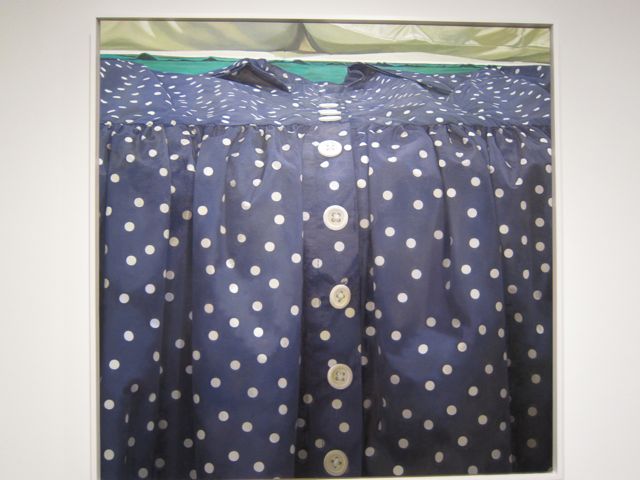An Evening with Catherine Murphy

Polka Dotted Dress, Catherine Murphy
It’s not a common thing to hear a talk by a representational painter in an academic setting these days. Artists of all kinds doing every kind of work intrigue me, but Catherine Murphy’s description of her journey was especially gripping for the way it reminded me of my own. We were both art students in a time when it seemed like nearly all art professors were Abstract Expressionists. They had come of age in post-war America and were, to generalize, fiercely devoted to one way of making art. To be an observer and recorder was to be uncomfortable in their classes– in my case often derided in their critiques.
Catherine Murphy described a similar experience. She received a BFA in painting from Pratt, taught by Minimalists and Abstract Expressionists, and once graduated, had to create her own vocabulary for representation. I identified with her youthful coming to know that she wanted to tell a story, as she said, about “the electricity of the world”.
I remember at that young age recognizing with a certain irony that I was a kind of rebel who refused to paint as these professors insisted I must, seeking instead to tell my story with a more traditional vocabulary. I think I’m still a rebel, painting in this way in the digitized 21st century when the pronouncement has been made a million times that painting is dead, a time when we are deluged with art about being deluged with information. Murphy said that all painting is a narrative. The question is how are you going to tell the story. Will it be poetry or prose?
One statement of hers struck me like thunder. She said “you can do things that are better than you are, that are smarter than you are.” I have done this. And those paintings sometimes take me years to understand and accept. I am intellectually not yet at the level of this thing that I have delivered into materiality.
Catherine Murphy went on to describe her growth as an artist, as she moved from painting what was around her into setting up scenarios that described a moment, an incident, or an idea. They became carefully crafted metaphors instead of accidental sightings. When workers dug a hole in her yard for the purpose of planting a tree she knew she had to paint it. It was the perfect metaphor she was seeking. The tree got planted and she had another hole dug just like first one to serve as a model for her laborious process. She described her sense of painting that hole as “when I can make something that is nothing into everything”. For me that is a core value: to take the unnoticed, the “unimportant”, and render it in such a way that something of the scope of life on earth is expressed as poetry in that visual scrap.
Of everything said that night, the work spoke loudest. I saw the way this artist was captivated by “the electricity of the world” and I know in my bones that same feeling, though my obsession is more and more with the natural world. I inherited that obsession from my father who grew up walking the fields and woods. He said he was hunting, but even as a child I knew he used that as an excuse to inhabit the woods. A day or so before he died, at the age of 48, I watched him from an upstairs window as he pulled into the driveway. He parked the car, and sat there, studying the tall whispering pine trees for a long time– as if to memorize them or say goodbye to them. I had a jolt of recognition in that moment of our matching souls. I have referred to my own work as “elegiac” because there is a certain sadness there, watching the culture I live in have total disdain for my lover, the naked and vulnerable earth.
I write this with a bluegrass concert playing in the background and I would be remiss were I to fail to mention the poetry of the bent note, the minor key, weaving its way into this narrative. How like a blanket these art forms are, wrapping us up. They comfort us with their assertions that making things is important, and stories, told in whatever voice, link us soul to soul.


Recent Comments